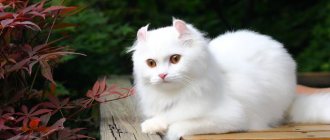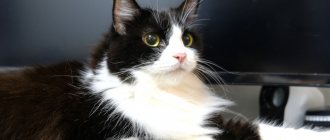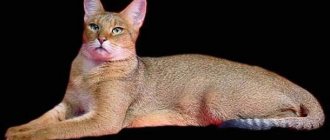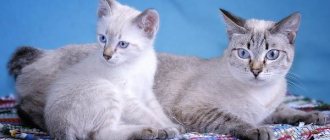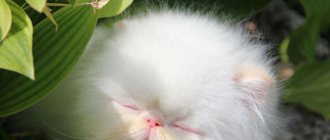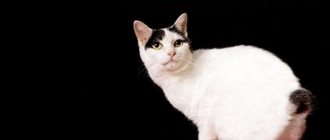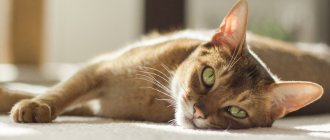- Wild animals
- >>
- Mammals
The British Golden Chinchilla is the name for the color of British cats, or simply a subspecies of the British. The breed itself is distinguished by its amazing kindness and complaisance. It is this color that arouses the greatest interest among breeders of purebred cats, as it is very rare. The homeland of this incredible beauty is considered to be Great Britain, which is where the name British cat comes from. She belongs to the young breeds. A distinctive feature is a very beautiful, fluffy and soft coat.
Origin of the species and description
Photo: British Golden Chinchilla
Breeders from Great Britain artificially bred it as a result of crossing Persians with the British. Today, there are several options for the origin of this type of breed. The origin story is described differently in different sources. Some indicate that the subspecies was first bred in England, while others indicate that scientists and breeders from America were involved in their breeding.
They were called chinchillas due to the fact that their color is very similar to the natural color of chinchillas. British scientists selected exclusively smoky or peach-colored cats for crossing. Initially, as a result of experiments, animals with green eyes and chinchilla color appeared.
Video: British Golden Chinchilla
The very first kitten was born as a result of crossing in 1882. A female kitten named Shannie was born from a Persian cat and a British smoke-colored cat. After this, breeders continued to work on developing ideal representatives of this breed. In 1889, a kitten was born who was named Silver Lambkin. It is this kitten that is considered the ancestor of this type of breed. It was presented as a result of breeding work at numerous exhibitions, where it became a multiple winner.
Interesting fact: Swedish Princess Victoria adored these animals and kept several representatives of this breed in her palace. The princess called them plushies and in every possible way contributed to their breeding and distribution.
For a long period of time, breeders sought to breed cats that would have emerald eyes. However, admixtures of different breeds did not allow achieving the desired result.
How to buy a kitten
How much does a kitten cost? The price of each Golden Chinchilla cat is determined depending on many parameters: gender, ear shape, color (ticked or not), purpose of purchase (for home, exhibition or breeding). Pedigree, health status, and the results of genetic testing are also taken into account.
Kittens intended for exhibition or breeding work are valued at several thousand dollars, since they are exclusive specimens. Seals that will not be used for breeding are offered for $400-600.
Appearance and features
Photo: What does a British golden chinchilla look like?
The British Golden Chinchilla has external characteristics typical of British cats. Representatives of this breed have a rather large body and a wide chest. Cats have a straight back line and a defined hip line. The body is quite squat with well-developed muscles.
Representatives of this breed have characteristic features:
- neat rounded head shape with a wide, majestic forehead;
- pronounced, large cheeks and cheekbones;
- wide, short, straight nose;
- the tip of the nose is pink or peach-colored;
- the ears are small, rounded, widely spaced from each other;
- the neck is shortened, muscular and strong;
- large, expressive eyes that are quite deep-set;
- limbs are short and strong, rounded, arranged proportionally. In the spaces between the toes there are tufts of thick hair;
- the tail is short, not long, thick.
Individuals of this species exhibit pronounced sexual dimorphism. Males have larger body sizes and weight. The average body weight of males is 6-8 kilograms, females 3-3.5 kilograms. Spayed or neutered individuals can reach almost double their body weight. The coat of British cats is quite dense, short and dense with a well-developed undercoat.
Among the colors, I distinguish three main types:
- silver - white predominates in this color scheme. The color is distributed in such a way that the undercoat is completely white, and the tips are darker, almost black. The chest and abdomen area is crystal white, the pads of the limbs, on the contrary, are black. The area of the eyes and nose is highlighted with a black outline, as if outlined with a pencil;
- golden - undercoat of a pronounced, rich apricot color. The tail, side surface of the body and the back line are painted in a darker color. The chest and belly area is a softer, lighter caramel color;
- ash - when compared with the usual silver color, the coat is darker. This is due to the fact that the guard hair is colored one-third dark, and the silver color is characterized by the guard hair being dyed the main color by 1/8. There are stripes of a darker color on the body, although they do not have clearly defined boundaries. Between the toes the fur is dark, almost black;
- Zoologists and breeders identify another color - color point. They have more pronounced external characteristics of Siamese cats. They are distinguished by the presence of blue eyes. And a darker eye color in the area of the ears, tail and eyes.
What are they?
Golden chinchillas come in short-haired and long-haired varieties. If it seems that caring for long hair is more difficult than short hair, then this is, of course, a misconception. Any animal needs care, and seasonal shedding simply cannot be avoided, either by animals with long or short hair. Everyone needs to be brushed constantly.
According to breed standards, golden chinchillas with green eyes are most often found, but options with blue and yellowish eye tints are not excluded. The blue color is mainly found in silver chinchillas.
Golden British chinchillas should not have a pronounced pattern on their coat; as a rule, these are soft and gentle transitions from one shade to another.
Where does the British Golden Chinchilla live?
Photo: British Golden Chinchilla cat
As representatives of an aristocratic breed, cats need special living conditions. Before you get such a cat, you should think about whether you can provide him with the proper living conditions. A prerequisite for a comfortable existence is cleanliness and order. Another important criterion is the optimal room temperature. These cats are not intended to be kept in outdoor conditions. They cannot tolerate cold, so the room temperature must be at least 22 degrees.
Unlike other cats, they tolerate loneliness well, and even love it. The less people and attention there are for the Scots, the more comfortable they will feel. However, they require attention and participation from the owner in their life. Coming home from work, the owner must take pity on his pet and pay attention to it. Be sure to keep your cat's ears clean. This is the weak point of representatives of this breed. Often, due to untimely cleansing, cats develop infection, suppuration, and infectious processes.
Such an aristocratic animal definitely requires personal space. In this regard, it is necessary to take care of the arrangement of the “house”. It is best if it is located in a secluded place, hidden from prying eyes. It cannot be said that golden chinchillas are demanding in terms of living conditions and care. However, there are some guidelines that you need to follow.
Animals' eyes should be wiped with a cotton pad moistened with boiled water. A weak solution of chamomile can be used as a solution. Cats need to brush their teeth once a day. Teeth cleaning is carried out with special hygiene products that are sold in veterinary pharmacies. Animals' nails should be trimmed at least once a month.
Reviews
All chinchilla owners speak highly of them; they are a sophisticated and wonderful breed that gets along well with children and brings a lot of pleasure to their owners.
These beauties move gracefully, rarely annoy people and rarely raise their voices. They like to sit next to the family when its members get together, for example, while watching TV.
The four-legged animals also look at the screen and watch the actions taking place there. They have an independent character and need privacy from time to time, but they also love to communicate.
What does the British golden chinchilla eat?
Photo: British Golden Chinchilla
Cats should be fed only fresh, high-quality food or ready-made balanced food specifically for cats. For nutrition to be balanced, the food must contain at least 35% protein.
Interesting fact: The owner is strictly prohibited from mixing different types of ready-made food for one feeding. This can cause illness and digestive problems.
You also need to count calories. This is not difficult if you use ready-made food as a source of nutrition. The average number of calories for one adult is 70 kcal per kilogram of live weight. It is also necessary to ensure constant access to fresh, clean water. It must be changed daily. It is better to pour bottled or filtered water into the bowl. You can’t exclude natural foods from your diet. If the diet is balanced, the animal will be healthy and active.
What is included in the animal’s natural diet:
- raw lean meat;
- boiled or stewed offal (liver, heart, lungs);
- sea white fish, which is cleaned of bones;
- dairy products with a low fat content (cottage cheese, yogurt without fillers, sour cream);
- two or three times a week you can give cats boiled eggs (preferably quail);
- boiled vegetables several times a week (preferably homemade vegetables - potatoes, carrots, potatoes);
- boiled porridge (buckwheat, rice, millet).
Interesting fact: Before giving raw meat to your cat, you need to freeze it for 10 hours to disinfect it. Before serving, it is defrosted and poured with boiling water. Be sure to cut the meat into small pieces.
If the animal has silky, soft and shiny fur, then the cat is well-nourished, and its diet is filled with everything it needs. There is a list of products that are strictly contraindicated to be included in the diet of animals.
What is forbidden to give:
- canned food;
- smoked meats;
- sausages and sausages;
- hot, salty and spicy dishes;
- raw cow's milk;
- canned meat or fish.
This breed of cat is prone to overeating and obesity. In this regard, the owner must himself dose the amount of food required for the normal growth and development of his pets. It is better to feed them in small portions five to six times a day. Be sure to sow special cat grass in the autumn-spring period, which cats can nibble.
Now you know what to feed your British golden chinchilla. Let's see how to breed these cute cats.
Breeding
Breeding golden chinchillas is not a very simple matter even for experienced breeders. The main difficulty is the key to obtaining the desired color. It's not easy to choose a partner. If your plans are only for breeding, without participating in exhibitions, then you can mate your pet with an individual of the opposite sex of any chinchilla breed with a silver or gold color
If participation in exhibitions is important, then you need to select the ideal pair. It must be a purebred cat of the same breed and color as the female cat
The first age for mating a cat is approximately one and a half years old. It can be carried out immediately when estrus appears. The interval between matings should be at least 4 months. After mating, the chinchilla sleeps a lot. When pregnancy occurs, the belly becomes noticeable after about a month, and its duration is 9 weeks.
If your pet has kittens with a pedigree, then after a month and a half you need to contact a special club or organization that will identify the pedigree of the babies and issue special passports for them. This will serve as a kind of permission for the official legal sale of kittens. The price for kittens of the breed is different, ranging from 10,000 to 40,000 rubles, the more purebred the kitten and the closer to the standards, the more expensive its price. Scottish and British golden chinchillas are more expensive, Persian ones are somewhat cheaper.
Features of character and lifestyle
Photo: British Golden Chinchilla cat
British golden chinchillas are distinguished by a gentle disposition, which is combined with independence and pride. With good care and love, the animal sincerely becomes attached to its owner with all its heart, at the same time considering itself to be his equal. Cats of this breed are very calm, balanced and not at all emotional. It is unusual for them to show their feelings; in any situation they prefer to take the position of an observer and not take any part in the affairs of others. Many cats perceive observation as their immediate responsibility.
To live in harmony with such an amazing beauty, you must sincerely love animals. It is unlikely that such a cat will be perceived as a plush toy. Cats endure all forced squeezing, hugging and expression of their feelings with their characteristic composure and detachment. They do not particularly welcome this method of communication, but they do not show aggression. These cooks don't like too much attention, a lot of people and noise around. They are lovers of a measured, understandable and familiar way of life.
It is unlikely that you will be able to achieve anything from animals using force and pressure. An animal listens to a person and does something only if the person is perceived by them as an authority. Chinchillas are very smart and quick-witted, making them highly trainable with the right approach. They are always ready to make contact if they respect and love their owner.
Golden chinchillas are real aristocrats, as they quickly get used to order and try to adhere to it throughout their lives. They will never cause mischief or damage property. Animals are considered very proud, it is unusual for them to beg and beg for food, they will not be content with scraps from the master’s table, even if they are too hungry. Communication with children is perceived by cats as incredibly evil. They do not like children too much, but they tolerate them, trying at every opportunity to simply hide from their obsessive attention and genuine interest.
Breeding
Golden chinchillas are very expensive to breed. The price of individuals for castration or sterilization usually varies between 15-40 thousand rubles, and for breeding an animal with all the documents and pedigree can cost as much as 100 thousand rubles.
Knitting animals is not recommended for amateurs. It is worth understanding that only specialized nurseries are engaged in such professional activities. But if you want to start your own business, then you should weigh the pros and cons, calculate all the costs and think about where the animals will be kept. And only then should you purchase a pair of beautiful golden chinchillas.
Mating is a painstaking task, and so is caring for a pregnant cat.
Social structure and reproduction
Photo: British Golden Chinchilla kitten
It is recommended to breed animals by professionals who have experience in this field. The British Golden Chinchilla is bred mainly in specialized nurseries. Before breeding cats at home, you should study the intricacies of this matter. Zoologists warn that this breed is not fully formed. During mating and pregnancy, cats need special care and attention. The first step is to take care of choosing suitable partners for breeding.
Criteria for selecting partners:
- the presence of all the characteristics characteristic of this breed in candidates for mating;
- absence of diseases and hereditary pathologies;
- healthy appearance;
- activity;
- availability of all necessary documentation;
- availability of a vaccination passport and all vaccinations in it.
Golden chinchillas are characterized by late development. It is recommended to get them at a time when they become independent, can go to the toilet on their own and eat adult food.
Price
If you decide to buy a kitten, it is better to do it in a large nursery, this way you will definitely protect yourself from deception. In addition, the seller will continue to advise you regarding care and maintenance. The cost depends on the class, there are three in total.
A pet, usually purchased only for the soul, will cost you about thirty thousand rubles. Such individuals do not have a stellar career, but they are just as sweet and attractive as others, they just have deviations from the standard.
Breed, any representative of which can participate in exhibitions, costs approximately fifty thousand.
Show - the cats belonging to it are descendants of medalists and will definitely win awards in various competitions. They have a price of about seventy thousand.
Natural enemies of British golden chinchillas
Photo: What does a British golden chinchilla look like?
Due to the fact that animals live exclusively in domestic conditions, they have practically no natural enemies. By nature, cats are endowed with strong immunity and an incredibly stable psyche. However, they will require certain living conditions, regime and diet. If the rules for keeping animals are not followed, the risk of developing various diseases increases.
The following diseases are typical for this breed:
- polycystic kidney disease;
- retinal atrophy of the eyeballs;
- diseases of the gastrointestinal tract;
- malignant neoplasms;
- hypertrophic cardiomyopathy.
Each of the above diseases can lead to the death of the animal. If your cat becomes lethargic, indifferent to everything, her appetite decreases, and she refuses her favorite treats, you should immediately contact a veterinarian. Representatives of this breed are very sensitive to drafts. They can get pneumonia if kept in drafty or damp conditions.
To exclude oncological formations of the reproductive system, it is recommended to castrate cats and sterilize cats if you do not plan to breed them. It is best to have surgery at 6-7 months of age. It is also recommended to promptly take animals to the veterinarian for vaccination. In addition, it is necessary to regularly brush your pets' fur. Otherwise, when licking yourself, the hair gets into the stomach and can cause serious health problems and disrupt the functioning of the digestive tract.
Breed defects
British chinchillas are not very sick animals, their health is strong. However, genetic diseases that appear as a result of inbreeding are typical for the breed.
Tendency to diseases
British Chinchilla cats may be susceptible to certain diseases, including:
- Retinal atrophy. It is considered a hereditary pathology and can cause decreased vision or loss of vision.
- Polycystic kidney disease. A hereditary disease accompanied by the formation of fluid cysts. At the same time, the quality of blood purification deteriorates, which can provoke intoxication, sepsis and death.
- Hypertrophied cardiomyopathy. Hereditary pathology of the cardiovascular system. Can lead to blockage of blood vessels, pulmonary edema and death of the animal.
You can avoid purchasing a pet with genetic abnormalities by contacting a trusted breeder. At the first alarming symptoms, the cat should be immediately shown to a veterinarian.
Defects in appearance
The following are recognized as serious defects in the appearance of chinchillas:
- thin, sunken cheeks;
- obvious depression on the nose;
- sparse or excessively soft wool;
- high-set ears;
- excessively elongated muzzle;
- flat forehead.
Some shortcomings exclude the British from participating in the competition. These include:
- skeletal deformities;
- deafness;
- blindness;
- anomalies of the eyelids, teeth, jaws.
For your information. Chinchilla coloring has a number of nuances, and certain requirements are imposed on it. Only a specialist can understand the intricacies of animal coloring.
Playfulness
What British chinchillas love is to play. Seeing a thread with a bow at the end or another toy, they instantly forget about their solidity, sophistication and aristocratic manners. There is only a cat and his toy. Even older animals, not to mention kittens, are ready to chase a target for a long time, catching it, throwing it, temporarily releasing it and attacking again. Playing together will give a lot of pleasure to both the owner and the pet.
But this can also be called a disadvantage. You need to regularly spend at least a little time playing with your cat. Otherwise, the relationship may deteriorate - the cat will no longer perceive the owner as a close friend. And lack of mobility often leads to excess weight gain, which affects the well-being and health of the pet.
Therefore, it is best to get British chinchillas for large families with many children who are ready to regularly find time to play with their favorite pet.
Predisposition to diseases
The British Shorthair has a long history, and one of the results of meticulous selection is that these animals have excellent health and excellent disposition. This is a long-lived breed. However, due to crossbreeding with Persian cats, some members of the chinchilla variety sometimes have kidney disease, although this is not common.
Polycystic kidney disease and blood type B
In the 20th century, British Shorthair breeders used Persian cats to create a chinchilla line. Persians are prone to an inherited kidney disease called polycystic kidney disease. Since then, outbreaks of this disease have been periodically reported in the UK.
A more common problem for British cats is the rare blood type that some of these cats have. British Shorthairs can be Type A or Type B. Most have Type A blood. Some have Type B. It is not a blood disorder, and Type B cats are just as healthy as Type A cats. But for breeding purposes or if blood transfusions are needed this must be taken into account. Type A blood will kill a cat with type B blood and vice versa.
British shorthair breeders are worried about blood type due to "fading kitten" syndrome. When the mother cat has type B blood and the father of the kittens has type A blood, their kittens can have both type A and type B blood. Mother's milk contains antibodies to type A, which will kill type A kittens within 72 hours. Fortunately, there is now a DNA test to check the blood type before breeding a cat.
Conditions of detention
A cat's long and fluffy fur requires daily care. You need to comb it at least once a day, but it is acceptable to do this once every 2 days. Otherwise, tangles cannot be avoided. First, the animal is combed according to the growth of its fur, then against it.
On the muzzle and cheeks, the hair is combed towards the muzzle, that is, against the hair growth. Do not worry that the animal will behave restlessly during these manipulations. Chinchillas love to be brushed. Even against the grain.
Like most felines, chinchillas are small fans of bathing. In addition, frequent bathing can cause their fur to turn yellow. This can be avoided by using a special whitening shampoo. You should bathe your cat no more than once every six months, and you should be prepared for inappropriate behavior of your pet.
It is important to ensure that water and shampoo foam do not get into your cat's eyes and ears.
After water procedures, you need to wrap it in a warm towel and let it dry a little like that. You can dry your pet's fur with a hairdryer, setting it to warm air. It is not advisable to comb wet fur.
When brushing and checking your cat's body every day, pay attention to the fur between the pads of your toes. It can also be combed and, if necessary, trimmed.
Otherwise, the hair in these places will bunch up, rubbing the delicate pads.
An alternative to water and wash is to use dry shampoo. It does not require rinsing with water, but is simply combed out of the wool. First, you need to comb the fur coat, and then rub dry granules into the fur. After a while, the fur is combed out again. Dry shampoo should be used every 14-17 days. This will make the animal's fur fluffy, shiny, and remove excess fat and dirt.
You don’t need any special care for your ears; it’s enough to clean them with a cotton swab once a week or less often, as they get dirty. Only the visible part of the ear is cleaned. Trying to penetrate deeper, especially with a cotton swab, is dangerous for the animal.
But the eyes of cats, like their fur, require constant care. The fact is that individuals of this breed are prone to increased lacrimation, so the eyes need to be wiped every day with a soft damp cloth or a damp cotton pad.
While still a kitten, you should accustom your chinchilla to a scratching post, and trim the claws with special tools once a week. You only need to cut off a third of the claw, but if you cut most of it, the blood vessels passing through this part of the claw will be damaged.
As for walks, they are pleasant for the animal, but not necessary. If you live in a private house, you can let the cat out for a walk in the garden. Naturally, making sure that there is no danger for him there, and also putting an anti-parasitic collar on him. In the city, it is better to walk your pet on a harness.
It is important to keep the tray clean by regularly changing its contents. You can use any filler that is convenient for you.
If you follow these simple rules, then there will be no unpleasant odor in the house, and the animal will not shit outside its toilet.
White-pink
This color is obtained by crossing white Wilson and heterobeige chinchillas. It, in turn, is also divided into 2 types: heterozygous and homozygous. The white-pink heterozygous chinchilla has a white coat with beige spots of different sizes and locations. Sometimes only the ends of the hairs are colored beige, which creates the effect of a pinkish veil. The ears and nose are pink, but sometimes there are small beige spots on the ears.
The homozygous type of white and pink chinchilla is quite rare, due to which it is highly valued. Animals differ from the heterozygous form in that they have a predominant white color, pure pink ears without spots, and red eyes. Clearly limited beige and golden spots with this color are considered very rare.


